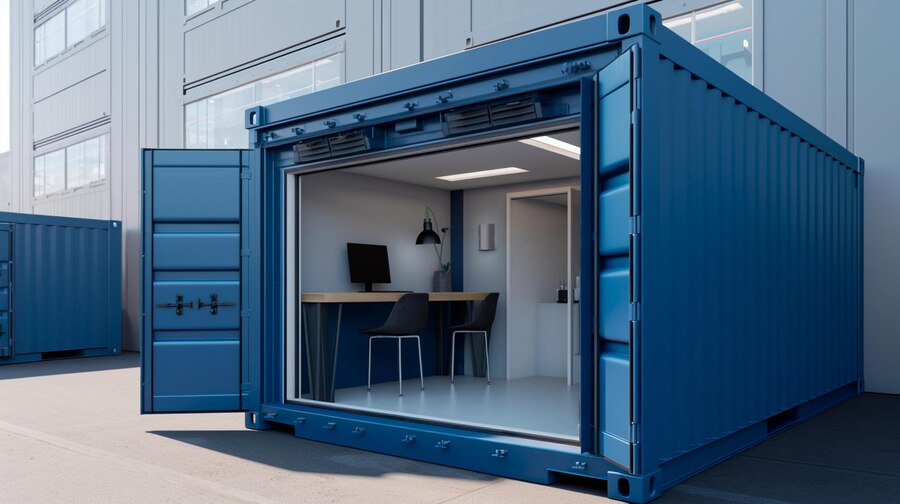An Essential Guide To Setting Up Your Shipping Container Office

Embarking on creating a shipping container office is as exhilarating as it is challenging.
This alternative workspace solution offers a blend of innovation, efficiency, and eco-friendliness. But before delving into the nitty-gritty of design and aesthetics, it’s essential to get the groundwork right, starting with permits, planning, and foundational choices.
To guide you, here’s how to set up yours seamlessly, ensuring that your container office isn’t only functional and aesthetically pleasing but also compliant and safe:
Checking For Planning And Building Permits
When setting up a shipping container office, it’s crucial to ensure compliance with local building codes and regulations. Many localities treat these container offices as permanent structures, mandating specific permits and code adherence.
Here are some tips to ensure compliance:
- Research Local Regulations: Begin with your local building department or city hall to grasp specific guidelines for container structures.
- Review Zoning Laws: Some places, especially residential areas, might have restrictions. Ensure your container office’s purpose aligns with permitted activities.
- Engage A Local Expert: Consultation with a seasoned local architect or builder can help clarify region-specific nuances and requirements.
- Prepare Detailed Plans: Detailed architectural plans, including layouts and modifications, are often required before permit application.
- Consider Utility Connections: For water, electricity, or sewage connections, additional permits or checks might be needed.
- Stay Updated: Building codes evolve over time. Stay informed, especially if you anticipate future modifications.
Remember, adhering to local regulations guarantees not just legal peace but also enhances the safety and longevity of your workspace.
Choose The Right Container Size
Determining the correct container size for your office is pivotal. It dictates how much space you’ll have to work with and the overall comfort and functionality of your environment. The container’s size should cater to the nature of your business, the number of employees, and future growth prospects.
Consider the following tips when selecting a container size:
- Evaluate Your Needs: Start by listing the essentials—desks, chairs, equipment, and storage. Visualize the arrangement.
- Factor In Growth: If you plan to expand your team or add more equipment, opt for a larger size or think about a modular design that allows for expansion.
- Consult A Specialist: Engage with experts who’ve handled similar projects. Their insights can guide you toward the optimal choice.
Your container’s size serves as the foundation for your office setup. Make sure it’s the right fit from the get-go. It’ll save you time, money, and potential hassles down the road.
Inspect And Prepare The Container

Before transforming a shipping container into an office, a thorough inspection is crucial. Remember, these containers have seen wear and tear from their journeys across the world. Preparing them correctly ensures a safe and comfortable workspace.
Here are some ways to ensure a proper and thorough inspection and preparation:
- Check For Damages: Look for dents, rust spots, or holes. Such imperfections might compromise the container’s integrity and your comfort.
- Test For Waterproofing: Seal any gaps or leaks. Containers must be watertight to prevent mold and water damage.
- Ensure A Clean Slate: Clean the interior thoroughly. Removing grime and dirt provides a healthy starting point for further modifications.
- Insulation And Climate Control: Shipping containers can become extremely hot or cold due to their metal construction. Consider implementing layers of insulation and installing efficient HVAC systems to regulate the container’s internal temperature year-round.
Paying close attention to the container’s condition and addressing any issues head-on lay the groundwork for a seamless office transformation.
Plan Your Interior Layout
Designing the interior of a shipping container office is pivotal to your daily operations. An apt layout can elevate productivity and promote well-being. Given the limited space, every design choice matters.
Here are some tips to optimize your container’s interior:
- Prioritize Movement: Keep ample space for easy and comfortable movement; avoid overstuffing with furniture.
- Multipurpose Furniture: Opt for items like foldable desks or seating with storage, balancing function with style.
- Zone Your Space: Segment the container into areas such as work, relaxation, and storage for organized efficiency.
- Add Windows And Doors: Introduce windows for natural light and doors, like sliding versions, to smartly demarcate zones.
- Incorporate Storage Solutions: A tidy space is crucial. Use vertical shelves, under-desk storage, or pegboards to manage essentials without clutter.
With mindful planning tailored to your routines and needs, you can transform your container into an efficient, harmonious workspace.
Set Up Electrical And Networking Systems
When transforming a shipping container into an office, setting up robust electrical and networking systems is vital. It’s not just about powering devices but also ensuring consistent connectivity for seamless operations.
Here’s a concise guide for this phase:
- Map Out Outlets: Visualize your layout first. Position outlets near desks and appliances, reducing the need for extension cords.
- Safety First: Incorporate ground-fault circuit interrupter (GFCI) outlets to mitigate electrical shocks. Additionally, consider hiring a professional to tackle the wiring.
- Connectivity Is Key: While Wi-Fi offers flexibility, an Ethernet connection provides stability. Strategically position routers and include multiple ports.
- Backup Power: Depending on your locale, consider investing in a backup generator or uninterruptible power supply (UPS) system for uninterrupted work.
- Stay Neat: Use cable management techniques for a tidier, hazard-free workspace.
- Think Ahead: Technology advances quickly. Make your setup flexible for future tech enhancements.
A well-thought-out electrical and connectivity plan ensures your container office remains a modern, efficient workspace, ready for the digital era’s challenges.
Choose Suitable Flooring
Flooring might seem like a mere aesthetic choice, but in a shipping container office, it carries added significance. From insulation properties to durability under daily wear and tear, the right flooring can profoundly impact the comfort and functionality of your workspace.
Here are some optimal flooring choices:
- Vinyl Flooring: A water-resistant, durable option, vinyl mimics wood or tile designs affordably. It’s low-maintenance and easy to install.
- Laminate Flooring: Cost-effective compared to hardwood, laminate is resistant to scratches. It provides a sleek, professional finish.
- Cork Flooring: Eco-friendly cork provides natural insulation. Its cushioned surface alleviates foot fatigue.
- Engineered Hardwood: Get the appeal of hardwood without the vulnerability to humidity shifts—vital in metal containers prone to temperature variations.
- Carpet Tiles: These versatile tiles provide comfort. Damage to one tile doesn’t mean redoing the entire floor; you just need to replace the affected piece.
- Rubber Flooring: Ideal for industrial-themed spaces, rubber is durable, sound-insulating, and easy to maintain.
Choosing the perfect flooring involves balancing operational needs, regional climate, and stylistic preferences. A well-selected floor amplifies both functionality and charm in your container workspace.
Prioritize Safety And Security

In transforming shipping containers into workspaces, blending aesthetics and functionality is paramount. Equally essential, though sometimes neglected, is the safety and security of your container office, given its unique structure.
For a secure shipping container office, consider the following:
- Install Surveillance Systems: Cameras can oversee your container’s surroundings, enhancing peace of mind.
- Opt For Quality Locks: Invest in high-grade padlocks, deadbolts, or electronic locks to deter potential break-ins.
- Light Up The Perimeter: Illuminate entry points and pathways at night as a deterrent.
- Prioritize Fire Safety: Outfit your container with smoke alarms and fire extinguishers and routinely inspect them.
- Regular Inspections: Check for potential hazards, like rust, and address them swiftly.
- Invest In A Security Alarm: An alarm system, potentially linked to security services, boosts your defense mechanism.
Safety and security in your container office ensure a confident, worry-free work environment. As you set up, these protective elements should be front and center.
Personalize Your Space
Crafting a functional shipping container office is essential, but integrating personal touches elevates the space. Infusing the office with elements reflecting one’s style and personality not only augments its visual allure but also positively impacts productivity and mood. A personalized workspace can serve as a source of daily motivation and inspiration.
Consider these strategies to infuse personal charm:
- Pick A Theme Or Color Palette: Choose colors or themes that echo your preferences. Be it a soothing blue, vibrant yellow, or a sleek monochrome scheme, this choice dictates the workspace ambiance.
- Integrate Art And Decor: Incorporate pieces like wall art, family photos, or inspiring quotes to anchor the space or spark daily motivation.
- Invest In Comfortable Furnishings: Go for ergonomic furniture and enhance with cushions, blankets, or area rugs for added warmth.
- Experiment With Lighting: Mix different lighting types, like task lights and ambient fixtures, to create your desired atmosphere.
Personalizing a container office transcends mere decoration; it’s about forging a space that resonates, offering both comfort and inspiration.
Conclusion
Embracing the shipping container office trend offers numerous benefits, from flexibility to sustainability. With this guide, setting up your new workspace should be a breeze. Remember, the key is to prioritize functionality without compromising on style or comfort. Happy setting up!
Read Also:
- Shipping Container Magic: Your Key To A Seamless Relocation
- How to start a logistics company? an expert guide
- Vital Tips For Packing And Shipping Items Safely
- FOB Shipping Point vs FOB Destination Point? Essential Points Of Difference
- CFR Vs CIF: What Are The Differences Between These Shipping Terms?













